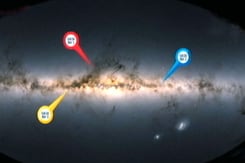Space Discovery
- All
- News
- Videos
-

JWST Detects Thick Atmosphere on Ultra-Hot Rocky Exoplanet TOI-561 b
- Sunday December 14, 2025
Astronomers using the James Webb Space Telescope have discovered compelling evidence of a thick atmosphere surrounding TOI-561 b, an ultra-hot rocky exoplanet orbiting its star every 11 hours. Despite extreme radiation and molten surface conditions, the planet appears cooler than expected, suggesting heat-redistributing atmospheric winds and volati...
-
 www.gadgets360.com
www.gadgets360.com
-

Top Scientific Discoveries Of 2025: A Year of Quantum Leaps And Cosmic Revelations
- Thursday December 11, 2025
- Offbeat |
Here's a look at scientific discoveries and breakthroughs that made headlines in 2025, spanning space, biology, ecology, and fundamental physics.
-
 www.ndtv.com
www.ndtv.com
-

Galaxy Collisions Found to Activate Supermassive Black Holes, Euclid Data Shows
- Friday December 12, 2025
Astronomers using ESA’s Euclid telescope and AI analysis have found that merging galaxies are significantly more likely to host active supermassive black holes. The gravitational chaos of a collision drives gas toward the galactic core, igniting AGN activity. This discovery strengthens the link between galaxy interactions and the energetic proces...
-
 www.gadgets360.com
www.gadgets360.com
-

ESA Telescopes Capture Ultra-Fast Winds Blasting From Distant Supermassive Black Hole
- Thursday December 11, 2025
Astronomers have witnessed an extraordinary black hole outburst in the galaxy NGC 3783, where material was blasted into space at nearly 20% the speed of light. Triggered by an intense X-ray flare, the ultra-fast winds reveal how supermassive black holes can violently shape their surroundings and influence the evolution of entire galaxies.
-
 www.gadgets360.com
www.gadgets360.com
-

NASA’s Perseverance Records First-Ever Mini-Lightning on Mars
- Tuesday December 2, 2025
NASA’s Perseverance rover has captured the first confirmed mini-lightning sparks in Mars’ dusty atmosphere. Using its sensitive microphone, the rover recorded 55 tiny electrical discharges during dust storms over two Martian years. These sparks generate reactive chemicals that can break down organic molecules, affecting future life-detection ef...
-
 www.gadgets360.com
www.gadgets360.com
-

Indian Team Finds 53 Massive Quasars Blasting Jets Millions of Light-Years Long
- Tuesday December 2, 2025
Astronomers in India have identified 53 previously unknown giant radio quasars powered by supermassive black holes, each releasing enormous plasma jets reaching up to 7.2 million light-years—nearly 50 times the Milky Way’s diameter. Using GMRT data, the team expanded the catalog of known giant quasars and offered valuable clues about how black ...
-
 www.gadgets360.com
www.gadgets360.com
-

James Webb Space Telescope Finds Unexpected Ultraviolet Radiation Around Young Protostars
- Monday December 1, 2025
Astronomers using the James Webb Space Telescope have detected unexpected ultraviolet radiation around five young protostars in the Ophiuchus molecular cloud. Since infant stars are not expected to emit UV light, the finding challenges long-standing star-formation models. Researchers ruled out external illumination from nearby stars, concluding the...
-
 www.gadgets360.com
www.gadgets360.com
-

Chernobyl's Black Fungi Thrive On Radiation And Could Help Protect Life In Space
- Sunday November 30, 2025
- Science |
This cool discovery in the ruins of Chernobyl is now helping to understand how life on Earth copes with radiation, and how humans can stay safe in space in the future.
-
 www.ndtv.com
www.ndtv.com
-

X-Ray Nebula Discovery Brings Astronomers Closer to Solving Cosmic Ray Mystery
- Friday November 28, 2025
A new study has linked an unexplained LHAASO detection to a pulsar-powered X-ray nebula, confirming it as a rare PeVatron capable of accelerating particles to extreme energies. The discovery is a major step toward solving the long-standing mystery of galactic cosmic rays. Researchers are now combining X-ray, gamma-ray and neutrino observations to t...
-
 www.gadgets360.com
www.gadgets360.com
-

James Webb Space Telescope May Have Spotted the Universe’s First Stars, Astronomers Say
- Wednesday November 19, 2025
Astronomers using the James Webb Space Telescope have detected a distant, metal-poor galaxy whose unusually massive, ultraviolet-bright stars match the expected signatures of Population III — the universe’s first stars. Through the help of gravitational lensing and Webb’s infrared sensitivity, researchers observed light from just 800 million ...
-
 www.gadgets360.com
www.gadgets360.com
-

Webb Finds Phosphorus-Bearing Gas in an Ancient Brown Dwarf
- Monday November 10, 2025
NASA’s James Webb Space Telescope has detected phosphine (PH₃) in the atmosphere of the ancient brown dwarf Wolf 1130C, about 54 light-years away in Cygnus. This marks the first confirmed detection of a phosphorus-bearing gas in such a metal-poor object. The finding surprises astronomers, as phosphine was previously undetected in similar brown ...
-
 www.gadgets360.com
www.gadgets360.com
-

NASA's James Webb Space Telescope Telescope Challenges Old Theories on Mini-Neptune Worlds
- Friday November 7, 2025
New models suggest mini-Neptunes—planets smaller than Neptune with thick gas envelopes—may have solid rocky surfaces instead of molten magma. Data from NASA’s JWST revealed high-pressure atmospheres capable of compressing molten rock into solid crusts. This discovery challenges earlier assumptions and offers key insights into exoplanet compos...
-
 www.gadgets360.com
www.gadgets360.com
-

JWST Detects Thick Atmosphere on Ultra-Hot Rocky Exoplanet TOI-561 b
- Sunday December 14, 2025
Astronomers using the James Webb Space Telescope have discovered compelling evidence of a thick atmosphere surrounding TOI-561 b, an ultra-hot rocky exoplanet orbiting its star every 11 hours. Despite extreme radiation and molten surface conditions, the planet appears cooler than expected, suggesting heat-redistributing atmospheric winds and volati...
-
 www.gadgets360.com
www.gadgets360.com
-

Top Scientific Discoveries Of 2025: A Year of Quantum Leaps And Cosmic Revelations
- Thursday December 11, 2025
- Offbeat |
Here's a look at scientific discoveries and breakthroughs that made headlines in 2025, spanning space, biology, ecology, and fundamental physics.
-
 www.ndtv.com
www.ndtv.com
-

Galaxy Collisions Found to Activate Supermassive Black Holes, Euclid Data Shows
- Friday December 12, 2025
Astronomers using ESA’s Euclid telescope and AI analysis have found that merging galaxies are significantly more likely to host active supermassive black holes. The gravitational chaos of a collision drives gas toward the galactic core, igniting AGN activity. This discovery strengthens the link between galaxy interactions and the energetic proces...
-
 www.gadgets360.com
www.gadgets360.com
-

ESA Telescopes Capture Ultra-Fast Winds Blasting From Distant Supermassive Black Hole
- Thursday December 11, 2025
Astronomers have witnessed an extraordinary black hole outburst in the galaxy NGC 3783, where material was blasted into space at nearly 20% the speed of light. Triggered by an intense X-ray flare, the ultra-fast winds reveal how supermassive black holes can violently shape their surroundings and influence the evolution of entire galaxies.
-
 www.gadgets360.com
www.gadgets360.com
-

NASA’s Perseverance Records First-Ever Mini-Lightning on Mars
- Tuesday December 2, 2025
NASA’s Perseverance rover has captured the first confirmed mini-lightning sparks in Mars’ dusty atmosphere. Using its sensitive microphone, the rover recorded 55 tiny electrical discharges during dust storms over two Martian years. These sparks generate reactive chemicals that can break down organic molecules, affecting future life-detection ef...
-
 www.gadgets360.com
www.gadgets360.com
-

Indian Team Finds 53 Massive Quasars Blasting Jets Millions of Light-Years Long
- Tuesday December 2, 2025
Astronomers in India have identified 53 previously unknown giant radio quasars powered by supermassive black holes, each releasing enormous plasma jets reaching up to 7.2 million light-years—nearly 50 times the Milky Way’s diameter. Using GMRT data, the team expanded the catalog of known giant quasars and offered valuable clues about how black ...
-
 www.gadgets360.com
www.gadgets360.com
-

James Webb Space Telescope Finds Unexpected Ultraviolet Radiation Around Young Protostars
- Monday December 1, 2025
Astronomers using the James Webb Space Telescope have detected unexpected ultraviolet radiation around five young protostars in the Ophiuchus molecular cloud. Since infant stars are not expected to emit UV light, the finding challenges long-standing star-formation models. Researchers ruled out external illumination from nearby stars, concluding the...
-
 www.gadgets360.com
www.gadgets360.com
-

Chernobyl's Black Fungi Thrive On Radiation And Could Help Protect Life In Space
- Sunday November 30, 2025
- Science |
This cool discovery in the ruins of Chernobyl is now helping to understand how life on Earth copes with radiation, and how humans can stay safe in space in the future.
-
 www.ndtv.com
www.ndtv.com
-

X-Ray Nebula Discovery Brings Astronomers Closer to Solving Cosmic Ray Mystery
- Friday November 28, 2025
A new study has linked an unexplained LHAASO detection to a pulsar-powered X-ray nebula, confirming it as a rare PeVatron capable of accelerating particles to extreme energies. The discovery is a major step toward solving the long-standing mystery of galactic cosmic rays. Researchers are now combining X-ray, gamma-ray and neutrino observations to t...
-
 www.gadgets360.com
www.gadgets360.com
-

James Webb Space Telescope May Have Spotted the Universe’s First Stars, Astronomers Say
- Wednesday November 19, 2025
Astronomers using the James Webb Space Telescope have detected a distant, metal-poor galaxy whose unusually massive, ultraviolet-bright stars match the expected signatures of Population III — the universe’s first stars. Through the help of gravitational lensing and Webb’s infrared sensitivity, researchers observed light from just 800 million ...
-
 www.gadgets360.com
www.gadgets360.com
-

Webb Finds Phosphorus-Bearing Gas in an Ancient Brown Dwarf
- Monday November 10, 2025
NASA’s James Webb Space Telescope has detected phosphine (PH₃) in the atmosphere of the ancient brown dwarf Wolf 1130C, about 54 light-years away in Cygnus. This marks the first confirmed detection of a phosphorus-bearing gas in such a metal-poor object. The finding surprises astronomers, as phosphine was previously undetected in similar brown ...
-
 www.gadgets360.com
www.gadgets360.com
-

NASA's James Webb Space Telescope Telescope Challenges Old Theories on Mini-Neptune Worlds
- Friday November 7, 2025
New models suggest mini-Neptunes—planets smaller than Neptune with thick gas envelopes—may have solid rocky surfaces instead of molten magma. Data from NASA’s JWST revealed high-pressure atmospheres capable of compressing molten rock into solid crusts. This discovery challenges earlier assumptions and offers key insights into exoplanet compos...
-
 www.gadgets360.com
www.gadgets360.com



























